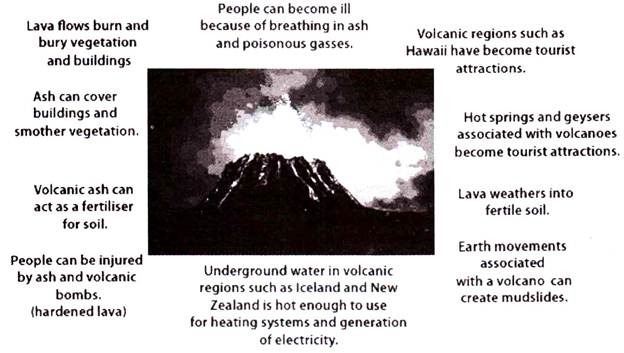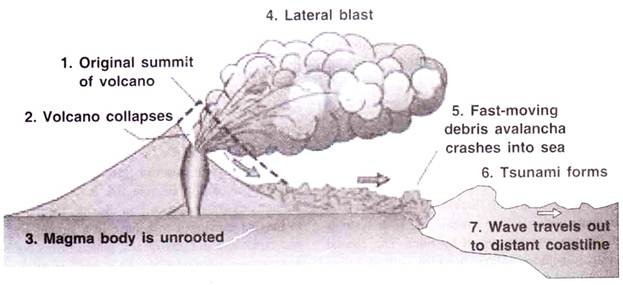Here is an essay on ‘Volcanoes’ for class 6, 7, 8, 9, 10, 11 and 12. Find paragraphs, long and short essays on ‘Volcanoes’ especially written for school and college students.
Essay on Volcanoes
Essay Contents:
- Essay on the Definition of Volcanoes
- Essay on the Occurrence of Occurrence
- Essay on the Causes of Volcano
- Essay on the Types of Volcanoes
- Essay on Volcanic Hazards
Essay # 1. Definition of Volcanoes:
A volcano is a vent or chimney which transfers molten rock known as magma from a depth to the Earth’s surface. Magma erupting from a volcano is called lava and is the material which builds up the cone surrounding the vent.
A volcano is active if it is erupting lava, releasing gas or generates seismic activity. A volcano is dormant if it has not erupted for a long time but could erupt again in the future. Once a volcano has been dormant for more than 10 000 years, it is termed extinct.
The explosiveness of a volcanic eruption depends on how easily magma can flow and the amount of gas trapped within the magma is released. Large amounts of water and carbon dioxide are dissolved in magma causing it to behave in a similar way as gas expanding in fizzy drinks, which forms bubbles and escapes after opening. As magma rises quickly through the Earth’s crust, gas bubbles are formed and expand up to 1000 times their original size.
Essay # 2. Occurrence
of Volcanoes:
Active volcanoes generally occur close to the major tectonic plate boundaries.
Many are located along the Earth’s plate boundaries. Active volcanoes are rare in Australia because there are no plate boundaries on this continent. However, there are two active volcanoes located 4,000 kilometres south-west of Perth on the Australian territories, Heard Island and the nearby McDonald Islands.
The other active volcanoes near Australia are in New Zealand, Papua New Guinea, Indonesia and the Philippines. Gas-rich sticky magmas dominate the Asia Pacific, making composite volcanoes and calderas the most common varieties in the region. These types of volcanoes severely threaten lives, property, agricultural lands and lifelines throughout south-east Asia and the Australian region.
Volcanoes can remain inactive or dormant, for hundreds of thousands of years before erupting again. During this time they can remain covered by vegetation making them difficult to identify. Once a volcano has been dormant for more than 10,000 years, it is termed extinct.
Evidence for volcanism throughout geological time can be found in every Australian State and Territory, with extensive volcanism down the east coast during the past 60 million years. This volcanic activity can be divided into areas where large amounts of lava flowed from diffuse dykes and pipes over a wide area and others where volcanism was produced from either a single central vent or a cluster of vents.
It is thought that the central volcanoes were produced as the Australian continent moved over a hot spot in the underlying mantle which melted through the plate to form the volcano. As the continent moved northward, the stationary hot spot formed volcanoes further to the south of the continent. As a result, the rocks of central volcanoes down the east coast become younger as one move southward.
Essay # 3. Causes of Volcano:
Volcanic activity frequently occurs at the boundaries of the Earth’s tectonic plates which are a series of large blocks moving between each other. The movement of these plates plays a significant role in the type of volcano formed which influences its shape.
i. Spreading Plate Margins:
Where plates move away from each other at spreading or divergent plate margins, volcanic eruptions are gentle extrusions of basaltic lava. Most of these occur underwater where magma rises from great depth below to fill the space created by seafloor spreading of which occurs at a rate of about 10 centimetres a year.
ii. Subducting Plate Margins:
At subducting plate margins, one plate is pushed under a neighbouring plate as they squeeze together. In addition to the old, weathered plate being forced down and melted wet sediment and seawater is forced down creating andesitic lava and more violent eruptions containing ash. These volcanoes form classic cone shapes.
Some volcanoes are found at great distances from plate boundaries and are referred to as intra- plate, within plate or hot spot volcanoes. These are formed above hot mantle upwellings or plumes which rise from great depths. As the plate overlying the plume moves away from the hot spot and a new volcano is formed, the previous one cools to become dormant and eventually extinct.
This sequence forms a volcanic chain such as the one currently found in the Hawaiian Islands. Hotspot volcanism forms very large, low gradient shield volcanoes and are similar in composition and eruption style to those found at divergent plate boundaries.
iii. Predicting Eruptions:
Understanding how volcanoes work and how their eruptions can be predicted is essential for the well-being and preservation of people who inhabit volcanically vulnerable areas. Eruptions can occur without any preceding signals, making them extremely difficult to predict. However, sometimes there are useful clues for judging when a volcano is likely to erupt.
A volcano’s eruptive history may provide some clues. However, because only a small number of the world’s volcanoes have a known history it is extremely difficult to predict future eruptions, particularly for certain types of volcanoes. This problem is typified by using the repose period, or the time between eruptions to indicate the expected size and strength of an eruption.
Consistently long repose periods may indicate that a volcano’s eruption is usually large and explosive. However, sometimes there is no clear relationship in the length of time between eruptions and the nature of the eruptions.
Earthquake activity around a volcano can provide valuable information. An eruption can be preceded by hundreds of small earthquakes known as earthquake swarms. Earthquakes also can indicate that magma is moving beneath a volcano. However, eruptions can occur with no perceivable change in seismic activity.
Small changes in the shape of a volcano such as bulging may indicate that magma is rising. Accurately measuring the summit and slopes of a volcano is one of the most important tools used for forecasting an eruption. Temperature changes in surface lakes or the groundwater near a volcano also can be a valuable early detection tool, although not all large changes in temperature are related to volcanic eruptions.
Gases emitted at, or near a volcano may show that a magma chamber is refilling or that a new composition of magma is rising from depth. Changes in the volume or type of volcanic gases produced also may be an indicator of magma activity.
Essay # 4. Types of Volcanoes:
Volcanoes can be different in appearance with some featuring perfect cone shapes while others are deep depressions filled with water. The form of a volcano provides a clue to the type and size of its
eruption which is controlled by the characteristics and composition of magma. The size, style and frequency of eruptions can differ greatly but all these elements are correlated to the shape of a volcano.
Three common volcanoes are:
i. Shield Volcano:
When magma is very hot and runny, gases can escape and eruptions are gentle with considerable amounts of magma reaching the surface to make lava flow. Shield volcanoes have a broad, flattened domelike shape created by layers of runny lava flowing over its surface and cooling.
Because the lava flows easily, it can move down gradual slopes over great distances from the volcanic vents. The lava flows are sufficiently slow for humans to outrun or outwalk them. This type of magma has a temperature between 800°C and 1200°C and is called basaltic magma.
ii. Composite Volcano (Strato):
Also known as strato-volcanoes, these volcanoes are characterized by an explosive eruption style. When magma is slightly cooler it is thick and sticky, or viscous, which makes it harder for gas bubbles to expand and escape.
The resulting pressure causes the magma to foam and explode violently, blasting it into tiny pieces known as volcanic ash. These eruptions create steep sided cones. They can also create lava flows, hot ash clouds called pyroclastic flows and dangerous mudflows called lahars. This type of magma has a temperature between 800°C and 1000°C and is called andesitic magma.
iii. Caldera Volcano:
These erupt so explosively that little material builds up near the vent. Eruptions partly or entirely empty the underlying magma chamber which leaves the region around the vent unsupported, causing it to sink or collapse under its own weight. The resulting basin-shaped depression is roughly circular and is usually several kilometres or more in diameter.
The lava erupted from caldera volcanoes is very viscous and generally the coolest with temperatures ranging from 650°C to 800°C and is called rhyolitic magma. Although caldera volcanoes are rare, they are the most dangerous. Volcanic hazards from this type of eruption include widespread ash fall, large pyroclastic surges and tsunami from caldera collapse.
Essay # 5. Volcanic Hazards:
Volcanic hazards include explosions, lava flows, bombs or ballistics, ash or tephra, pyroclastic flows, pyroclastic surges, mudflows or lahars, landslides, earthquakes, ground deformation, tsunami, air shocks, lightning, poisonous gas and glacial outburst flooding known as jӧkulhlaups. Each hazard has a different consequence, although not all occur in every eruption or in association with all the volcanoes.
Volcanic eruptions are measured using a simple descriptive index known as the Volcano Explosivity Index which ranges from zero to eight. The index combines the volume of material ejected with the height of an eruption column and the duration of the eruption.

